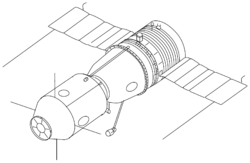Sojuz TM-24
| Sojuz TM-24 (Союз ТM-24) | |||
 | |||
| Modell | Sojuz-TM | ||
|---|---|---|---|
| Anrop | Фрега́т (Fregat - Frigate | ||
| Färdens tid | 196 dag, 17 tim, 26 min, 13 sek | ||
| Massa | 7 150 kg | ||
| NSSDC-ID | 1996-047A[1] | ||
| Uppskjutning | |||
| Startplats | Bajkonur LC1 | ||
| Start | 17 augusti 1996, 13:18:03 UTC | ||
| Raket | Sojuz-U | ||
| Landning | |||
| Landningsplats | 128 km Ö om Dzjezkazgan | ||
| Landning | 2 mars 1997, 06:44:16 UTC | ||
| Omloppsbana | |||
| Varv | 3 160 st[2] | ||
| Apogeum | 287,4 km | ||
| Perigeum | 235,1 km | ||
| Banlutning | 51,65° | ||
| Besättning | |||
| Start | Valerij Korzun Alexandr Kaleri Claudie André-Deshays | ||
| Landning | Valerij Korzun Alexandr Kaleri Reinhold Ewald | ||
| Dockning | |||
| Rymdstation | Mir | ||
| Dockning | 19 augusti 1996, 14:50:21 UTC | ||
| Port | fram | ||
| Ur dockning | 7 februari 1997, 16:28:01 UTC | ||
| Andra Dockning | 7 februari 1997, 16:51:27 UTC | ||
| Port | Kvant-1 | ||
| Andra ur dockning | 2 mars 1997, 03:24:57 UTC | ||
| Kronologi | |||
| |||
Sojuz TM-24 (ryska: Союз ТM-24) var en flygning i det ryska rymdprogrammet. Flygningen gick till rymdstationen Mir. Farkosten sköts upp med en Sojuz-U-raket, från Kosmodromen i Bajkonur den 17 augusti 1996. Den dockade med rymdstationen den 19 augusti 1996. Den 7 februari 1997 flyttades farkosten från rymdstationens främre dockningsport, till Kvant-1 modulens dockningsport. Farkosten lämnade rymdstationen den 2 mars. Några timmar senare återinträdde den i jordens atmosfär och landade i Kazakstan.
André-Deshays blev den första franska kvinnan i rymden.
Källor och referenser
- ^ ”NASA Space Science Data Coordinated Archive” (på engelska). NASA. https://nssdc.gsfc.nasa.gov/nmc/spacecraft/display.action?id=1996-047A. Läst 29 februari 2020.
- ^ Manned Astronautics - Figures & Facts Arkiverad 26 september 2015 hämtat från the Wayback Machine., läst 9 oktober 2016.
| |||||||||||||||||||||||||||||||||||||||||||||||||||||||||||||||||||||||||||||||||||||||||
| |||||||||||||
| ||||||||||||||||||||||||||||||||
Media som används på denna webbplats
Soyuz-A manned spacecraft concept (1963). It was to have been part of the Soyuz A-B-C circumlunar complex.
Apollo-Soyuz Test Project (ASTP) Soyuz. The APAS-75 docking unit is located at left.
Soyuz-TM spacecraft. Compare the antennas on the orbital module to those on Soyuz-T. Differences reflect the change from the Igla rendezvous system used on Soyuz-T to the Kurs rendezvous system used on Soyuz-TM.
The Soyuz TMA-04M spacecraft is seen after being rolled out by train to the launch pad at the Baikonur Cosmodrome in Kazakhstan, May 13, 2012. The launch of the Soyuz spacecraft, with Expedition 31 Soyuz Commander Gennady Padalka, Flight Engineer Sergei Revin of Russia and NASA Flight Engineer Joe Acaba, is scheduled for 9:01 a.m., May 15 (Kazakhstan time).
Författare/Upphovsman: Pascal (Flickr user: pasukaru76), Licens: CC0
Vostok spacecraft replica at the Technik Museum Speyer, Germany.
The official crew patch for the Russian Soyuz TM-24 mission, which delivered the EO-22 crew to the space station Mir.
MIR Space Station Emblem
The official crew patch for the Russian Soyuz TM-23 mission, which delivered the EO-21 crew to the space station Mir.
The official crew patch for the Russian Soyuz TM-25 mission, which delivered the EO-23 crew to the space station Mir.


















